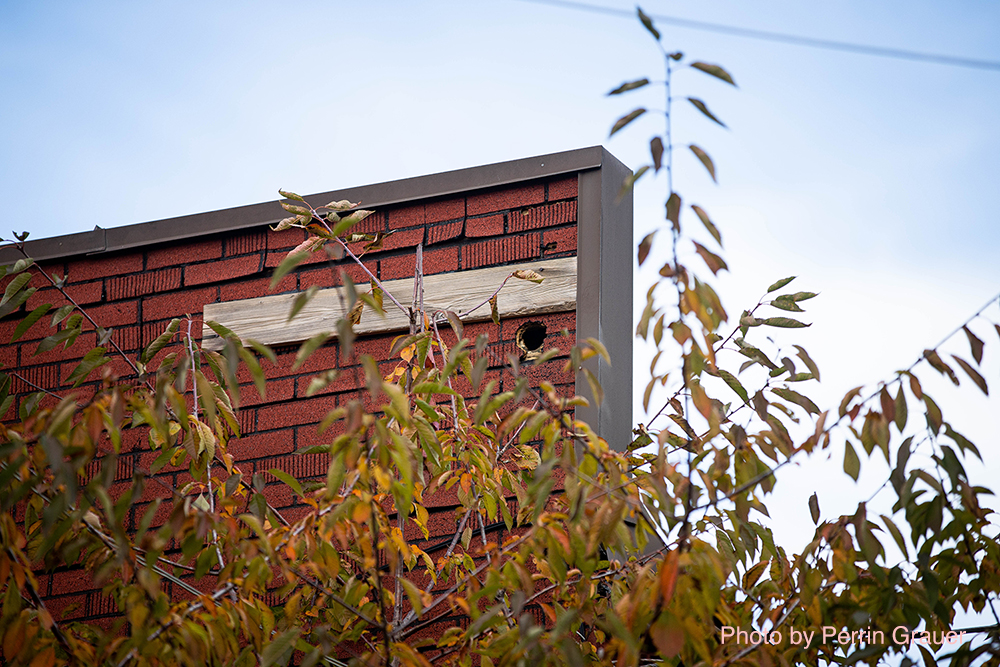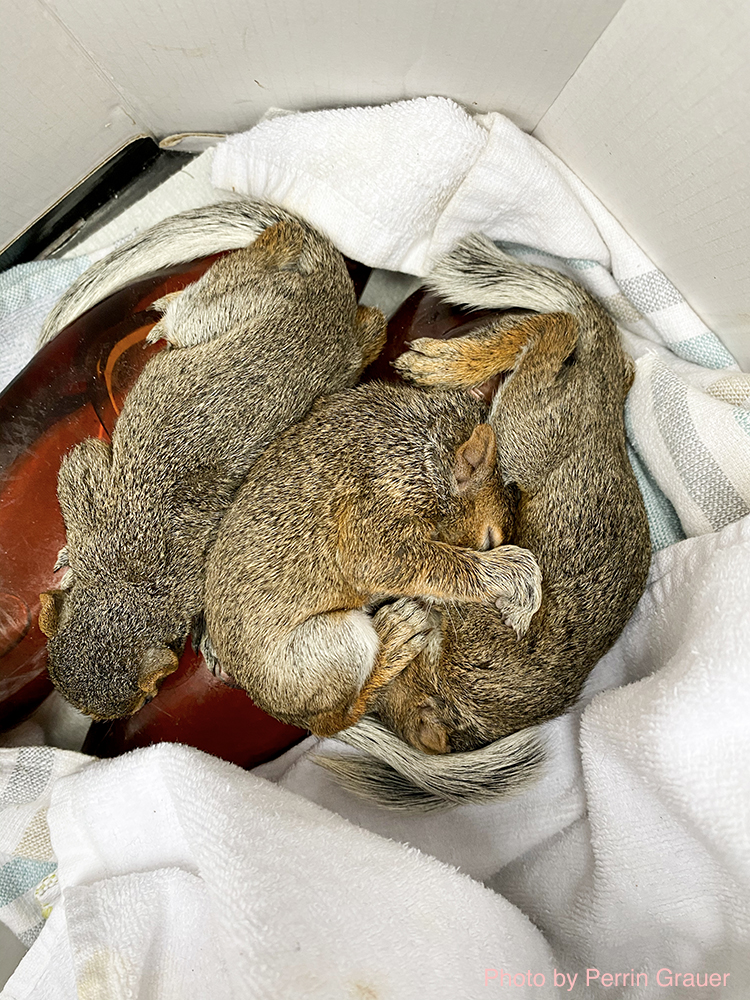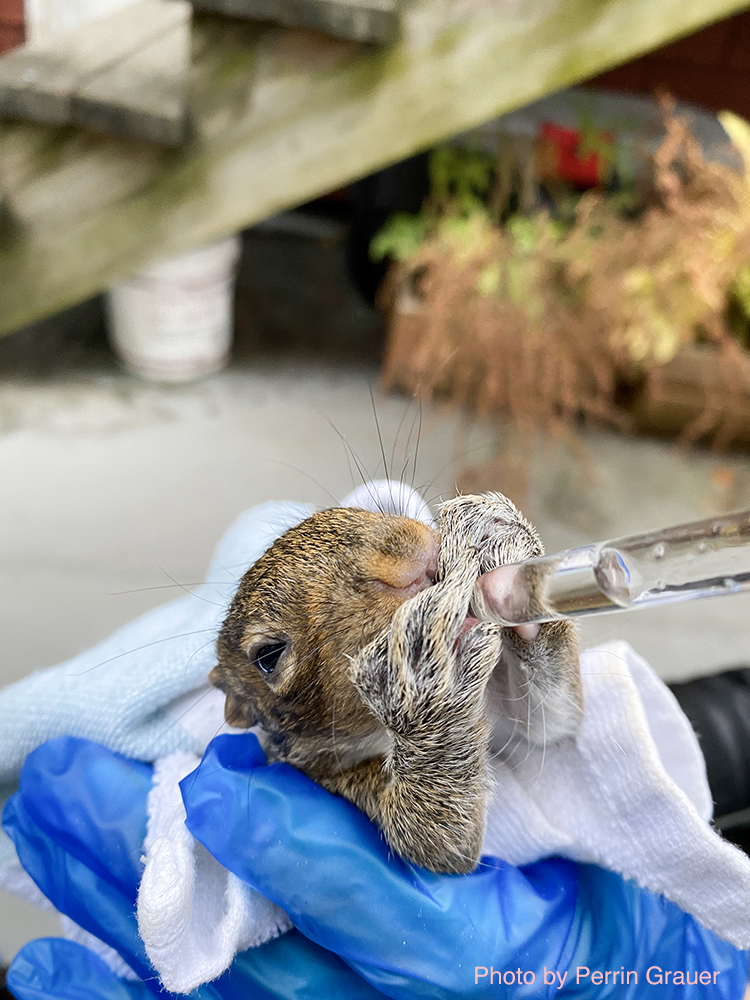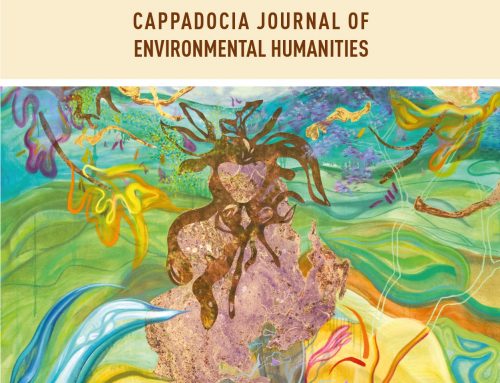
In early October 2020, on a Saturday afternoon, I returned to my old, falling-down apartment building in Vancouver’s Mt. Pleasant neighbourhood. The city was worming its way across a weird borderline from quiet dread under glowering, late-summer blankets of smoke heaved up from forest fires further south, toward the more familiar dolor of leaden West Coast autumns.
My slanting back porch and its tired vinyl envelope remained hidden from the avenue by a pair of sour cherry trees, which hold onto their leaves even now, on the cusp of November, as I write this. My next-door neighbour — the only other residential occupant of our two-unit building, whose leaky, single-pane windows face directly onto Main Street — stood outside his back door, peering into a tall octagonal box.
I asked him what he was up to.
“Baby squirrels,” he replied.
A chorus of alarming screeches had brought him running out of his apartment, he said, only to find a trio of juvenile animals screaming from the driftwood ledge of the porch. He’d called Wildlife Rescue and been told the group was likely abandoned; he should keep the squirrels warm and hydrated for 24 hours. If the mother hadn’t returned by that time, they told him, they would send a staff member to collect the animals for rehabilitation and release. But my neighbour is a shift worker and would be on the job for long hours all weekend.

I’ve lived in Vancouver nearly my entire life, and squirrels are a ubiquitous sight. While I’ve heard tales of their destructive power from friends who’ve had one infiltrate a home or wall, I was personally ambivalent about the animals. They’ve always been more or less part of the furniture. But peering into that box on my neighbour’s creaky stoop, I felt my heart melting. Two of them were curled into tight balls along the box wall, while the third scrabbled around aimlessly, mewling.
I offered to stand as foster parent for the weekend while my neighbour was at work, knowing my wife would be thrilled at the opportunity to help care for the tiny creatures. That evening and throughout the next day, we established a makeshift ritual of care. Every few hours, we put on blue nitrile gloves — a staple in our household from the early days of lockdown — and carefully extracted the squirrels from the box, one at a time, for feeding.
We filled plastic bottles with warm water — the evenings were quite cool at that time — which we rewarmed each time the squirrels were fed. Without fail, the trio was wreathed up in a fleecy grey knot each time we checked on them. It was a bizarre sensation to push an index finger into the middle of that living tangle, to slide a thumb beneath a puny spine, to pull them apart for feeding. Their bodies felt exceedingly fragile in my hands. Their tiny skeletons were palpable through their stretchy skin, and we held them gingerly, with no small amount of delight.
On recommendation from Wildlife Rescue, we gave them a homemade electrolyte; sugar and salt dissolved in warm water, and cooled for consumption. This was delivered via an eye-dropper, which they grasped at with oversize paws while feeding. The tiny creatures had underdeveloped thumbs and sharp, hooked claws. The rattle of their sharp teeth against the dropper vibrated up into my hand.
I was struck by the variegation of their fur; they’d always appeared perfectly dun from afar, but up close, they were all hues of black, grey, orange, and brown. I still don’t know if this is a characteristic of their subspecies, or whether they’ll grow into a solid colour as they age.
Remarkably, they also seemed fearless. If there was any resistance to our presence, it was because feeding time entailed their being pulled from their warm nest, between soft tea towels and the warmth of the water bottles. Immediately upon being returned to the box, they’d find each other again and wrap themselves back into one another. At some point, we placed a handful of raw nuts in the box as well, which they ignored.
During one of our earliest feedings, I must have squeezed water from the dropper too quickly, because the squirrel I was holding began to sneeze— tiny chirrups accompanied by a shaking head. At first, this was unbearably cute. But very quickly, paranoia kicked in. COVID-19 has famously been shown to be an interspecies infection, resulting from close contact between a human and one or more wild animals. I spent a day or two pretty nervous about whether I would be patient zero on some new squirrel pandemic.

We repeated our care ritual throughout the full 24-hour waiting period, but no mother returned. We contacted Wildlife Rescue again on Sunday evening, and were told the earliest they could come to collect the three beasts was Monday night. Which really wasn’t disappointing in the least.
Reflecting on how the squirrels had ended up on the porch, my neighbour suggested they may have fallen from a nest originally made by a family of neighbourhood red-shafted northern flickers. The group of beautiful birds — a species of woodpecker — has returned to our building every spring to pound holes into the rickety parapet. Presumably, the inside of the structure gives them plenty of room and safety, because they keep boring new holes in the wall, no matter how many times the landlord boards them up. It’s a two-day process, and by the sounds of it, they hammer away pretty much without relent, around the clock until their work is done. They raise their young there every spring, and then vanish.
My mother, who keeps tabs on a similar nest in a dying tree from her third-floor patio in Hastings-Sunrise, suggested the flickers may have forcibly evicted the squirrels; she recounted the birds in her own neighbourhood suddenly returning for a fall visit, right around the time the squirrels appeared on our porch. Perhaps, she said, the birds had found their beds occupied and taken up arms.
Monday evening, after more than 48 hours spent caring for the squirrels, Wildlife Rescue arrived to take the trio to their facility. It was a bittersweet goodbye, though I’m told the organization typically releases rescued animals back into the same areas they were found; this fact has admittedly sparked fantasies of the three squirrel siblings returning full-grown in years to come, for a visit.
Since I was a child, inventing songs about imagined friendships with animals, it’s been a dream that a good deed done for a non-human neighbour (which, to be fair, is something like a reward in its own right) would imprint me in its memory as a guardian or comrade or the like. Whether this daydream is in the least bit likely is beside the point. It’s a kind of solace to have provided warmth and safety for a helpless creature for a short time, especially as the world at large reels from crisis to crisis — an all-too-real ghost story haunting headlines and heavy hearts.
My daydream is my reward; a beautiful thing I can return to whenever I like. A comfort no one can touch.
Meanwhile, the squirrels, I’m told, are strong and healthy and due to be released before the end of the year.
Perrin Grauer, Oct. 30, 2020.
…………………………………………………
Synanthropes: Squirrel and Deer Stories
Hello! I have started an online storytelling format to gather your accounts of affinity, indifference, and aversion towards synanthropes (and in particular, the Eastern grey squirrel and Black-tailed deer). Synanthropes are somewhat adapted to living in proximity to human beings and are often seen as pests. Please note, stories are not published in order of receipt. Thanks to everyone for their submissions to date. If you would like to participate in this evolving project, please submit your story and photos here!



Get Social